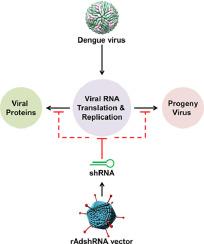Virus Research ( IF 5 ) Pub Date : 2021-07-30 , DOI: 10.1016/j.virusres.2021.198527 Hemalatha Beesetti 1 , Sathyamangalam Swaminathan 1

|
Dengue, a mosquito-borne viral disease, caused by any of four serotypes of dengue viruses (DENV-1, -2, -3 and -4), is estimated to affect >1 million of the world's population daily. We showed earlier that a recombinant human adenovirus type 5 (HuAd5) vector, encoding a short hairpin RNA (shRNA), targeting a conserved sequence in the DENV genome, could effectively suppress pre-established DENV-2 infection in Vero cells. In this study, we identified an additional conserved shRNA target in the DENV genome, developed a HuAd5 vector to target this site, and evaluated if HuAd5-delivered shRNAs suppress pre-established infection by the remaining three DENV serotypes, not only in Vero cells, but also in macrophages, the in vivo sites of DENV replication in infected individuals. We also assessed the effect of anti-HuAd5 antibodies on shRNA delivery.
We show that recombinant HuAd5 vectors, encoding shRNAs targeting conserved DENV genomic sequences, in the 5’ non-translated region and capsid gene, can suppress ongoing replication of all four prototypic DENV serotypes in Vero cells and in a HuAd5-refractory human macrophage cell line expressing a DENV attachment factor. DENV suppression was assessed on the basis of inhibition of viral antigen secretion, viral RNA replication and progeny virus generation. Interestingly, HuAd5 vector-mediated DENV suppression in the macrophage cell line was dependent on the presence of anti-HuAd5 antibody. This suggests that HuAd5 vector complexed to its antibody enters these cells through the Fc receptor pathway. This may have implications for specific targeting of HuAd5 vector-mediated antiviral RNA interference therapy to macrophages.
中文翻译:

编码针对登革热病毒 5' 非翻译区和衣壳基因的短发夹 RNA 的 5 型腺病毒载体抑制培养的上皮细胞和骨髓细胞中预先建立的登革热感染
登革热是一种蚊媒病毒性疾病,由四种血清型登革热病毒(DENV-1、-2、-3 和 -4)中的任何一种引起,据估计每天影响超过 100 万的世界人口。我们早先表明,一种重组人腺病毒 5 型 (HuAd5) 载体,编码短发夹 RNA (shRNA),靶向 DENV 基因组中的保守序列,可以有效抑制 Vero 细胞中预先建立的 DENV-2 感染。在这项研究中,我们在 DENV 基因组中发现了一个额外的保守 shRNA 靶标,开发了一个 HuAd5 载体来靶向该位点,并评估了 HuAd5 传递的 shRNA 是否抑制了其余三种 DENV 血清型的预先建立的感染,不仅在 Vero 细胞中,而且在巨噬细胞中,体内感染个体中 DENV 复制的位点。我们还评估了抗 HuAd5 抗体对 shRNA 递送的影响。
我们展示了重组 HuAd5 载体,在 5' 非翻译区和衣壳基因中编码靶向保守 DENV 基因组序列的 shRNA,可以抑制所有四种原型 DENV 血清型在 Vero 细胞和 HuAd5 难治的人类巨噬细胞系中的持续复制表达 DENV 附着因子。基于对病毒抗原分泌、病毒 RNA 复制和后代病毒产生的抑制评估 DENV 抑制。有趣的是,巨噬细胞系中 HuAd5 载体介导的 DENV 抑制依赖于抗 HuAd5 抗体的存在。这表明与其抗体复合的HuAd5载体通过Fc受体途径进入这些细胞。这可能对 HuAd5 载体介导的抗病毒 RNA 干扰疗法对巨噬细胞的特异性靶向有影响。



























 京公网安备 11010802027423号
京公网安备 11010802027423号